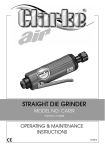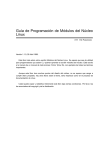Download Clarke CAT 89 Specifications
Transcript
DIE GRINDER MODEL NO: CAT 89 PART No: 3110845 OPERATION & MAINTENANCE INSTRUCTIONS 0902 CONTENTS Specifications .......................................................................... 4 Guarantee ............................................................................... 5 Safety Precautions .................................................................. 6 Operating Instructions ........................................................... 7 Maintenance .......................................................................... 7 Parts List & Diagram ............................................................... 8 Vibration Emmisions ...................... refer to notes on page 9 Blank Page ............................................................................ 10 Declaration of Conformity ................................................. 11 MODEL No: CAT89 DESCRIPTION: DIE GRINDER Declared vibration emmission value in accordance with EN ISO 8662-13 Measured vibration emmission value - a: <2.5m/s2 Uncertainty value - K: m/s2 Highest measured reading in a single plane 2.08m/s2 Values determined according to EN28622-1 Fig.1 SPECIFICATIONS Model : .......................................................................... CAT 89 Part No : ....................................................................... 3110845 Free Speed ........................................................... 20,000 RPM Collet Capacity ..................................................... 1/8” - 1/4” Maximum Air Consumption : ....................................... 8 CFM Maximum Air Pressure : .................................. 90 PSI (6.2bar) Air Inlet Size : ............................................................... 1/4” BSP Minimum Hose Size : ..................................... 5/16” (8mm) ID Weight : ........................................................................... 0.5 kg Overall Length ............................................................... 5-1/2” Please note that the details and specifications contained herein are correct at the time of going to print. However CLARKE International reserve the right to change specifications at any time without prior notice. Always consult the machines data plate Please read these instructions carefully before operating the tool Thank you for purchasing this CLARKE Air Die Grinder Before using the device, please read this manual thoroughly and carefully follow all instructions given. This is for your own safety and that of others around you, and is also to helpyou achieve long and trouble free service from your new tool. CLARKE GUARANTEE This CLARKE product is guaranteed against faulty manufacture for a period of 12 months from the date of purchase. Please keep your receipt as proof of purchase. This guarantee is invalid if the product is found to have been abused or tampered with in any way, or not used for the purpose for which it was intended. Faulty goods should be returned to their place of purchase, no product can be returned to us without prior permission. This guarantee does not affect your statutory rights. PARTS & SERVICE TEL: 020 8988 7400 or e-mail as follows: PARTS: [email protected] SERVICE: [email protected] ACCESSORIES A wide range of Airline accessories is available, including Filter/Regulators, Lubricators, High Pressure Hoses from 5 to 100 Metres, etc. Contact your CLARKE dealer for further information, or CLARKE International Sales Department on 01992 565300 SAFETY PRECAUTIONS AIR SUPPLY Tools of this type, operate on a wide range of air pressures. It is recommended that air pressure to this tool does not exceed 90 PSI (6.1bar), at the tool when running. Higher When operating this tool, ALWAYS wear: pressure and unclean air, will shorten the tools’ life because of faster wear, and could be a a. approved impact resistant SAFETY safety hazard. GOGGLES. (Eye glasses are NOT Water in the air line will cause damage to safety glasses) the tool, ensure it is properly maintained at b. a DUST MASK all times. c. EAR DEFENDERS The recommended procedure to connect d. a good pair of INDUSTRIAL GLOVES this tool to an air supply, is shown at fig. 1 on inside front cover. ALWAYS disconnect the tool when not in use, and before carrying out any The air inlet used for connecting air supply, maintenance has a standard ¼” BSP thread. ALWAYS keep a safe distance between Line pressure, or hose inside diameter, should yourself and other people when using be increased to compensate for unusually the tool. long air hoses (over 10m). Minimum hose ALWAYS maintain the tool with care.Keep diameter should be 6mm (¼") ID., and fittings it clean for best and safest performance. should have the same inside dimensions. NEVER wear ill fitting clothing, remove ASSEMBLY watches and rings. Quick change couplings should not be Connect a suitable hose to the Grinder using located at the tool. They add weight a ¼” hose adapter, (A whip hose with Quick and could fail due to vibration. Fit coupling is available from your CLARKE DO NOT over-reach. Keep your proper dealer). then connect the other end to the footing and balance at all times. airline. DO NOT force or misuse the tool. It will NOTE: ensure the airline is turned off. do a better and safer job at the rate for Your Grinder is now ready for use. which it was designed. IMPORTANT Failure to follow these precautions could result in personal injury, and/or damage to property. ❐ ❐ ❐ ❐ ❐ ❐ ❐ ❐ ❐ ❐ ❐ ❐ ❐ ❐ ❐ DO NOT abuse hoses or connectors. NEVER carry a tool by the hose, or yank it to disconnect from the air supply. Keep hoses away from heat, oil and sharp edges. Check hoses for leaks or worn condition before use, and ensure that all connections are secure. DO NOT exceed 90 PSI at the tool. DO NOT modify the tool in any way. DO NOT remove any labels. Damaged labels should be replaced. This tool vibrates with use. Vibration may be harmful to your hands or arms. Stop using the tool if discomfort, a tingling feeling or pain occurs. Seek medical advice before resuming use. ALWAYS use screens to protect people in the vicinity from flying debris. NEVER point the tool at anyone. WARNING Compressed air can be dangerous. Ensure that you are thoroughly familiar with all precautions relating to the use of compressors and compressed air supply. OPERATING INSTRUCTIONS Before starting work drain any water from the air tank and blow condensation from the air line. Drain compressor more frequently in hot humid weather. 1. Ensure Grinder is disconnected from the air supply. MAINTENANCE 2. Loosen collet nut, and insert appropriate Daily before use. grinding stone. Tighten collet using 1. Drain water from air tank, air line and spanners supplied. compressor. 3. Depress throttle lever and wait until motor 2. Check and clean, if necessary, the is running at full speed. air inlet gauze filter . 4. Cautiously offer stone to workpiece, 3. Pour a few drops of CLARKE Air Line DO NOT APPLY EXCESS FORCE, allow tool Oil (approx 3cc), into the air inlet. This to do the job for which it was designed, should be carried out regardless of too much pressure could cause stone to whether or not an air line lubricator shatter resulting in personal injury. is used. 5. When finished grinding, allow grinder to If an Air line lubricator is NOT used, stop running before carefully putting it this procedure should be repeated down. after every two to three hours of use. NOTE: Grinding stones come with two different size shafts 1/8” and 1/4”, therefore you will need to fit different collets, Your grinder comes with the 1/4” collet fitted. If the grinder is to be stored, or is idle for longer than 24 hours, run a few drops of Clarke Air Line Oil into the air inlet, and run the tool for 5 seconds in order to lubricate the internal parts. If you need to fit the 1/8” collet, follow For lubricating the air motor when in operation, an air line lubricator should be instructions below. used, with Clarke Air Line Oil, adjusted to 2 a: hold motor spindle from turning (Item drops per minute. 7) with spanner supplied. Clarke Air Line Oil is available from your b: remove collet nut and withdraw CLARKE dealer, part no. 3050825. collet, store for re-use. Be aware that factors other than the tool may c: install new collet and re-fit collet nut, effect its operation and efficiency, such as (finger-tight only). reduced compressor output, excessive drain on the airline, moisture or restrictions in the IMPORTANT line, or the use of connectors of improper size Never use chipped or cracked stones, or poor condition which will reduce air supply. always inspect before fitting. IMPORTANT: The use of parts other than CLARKE replacement parts may result in safety hazards, decreased tool performance and may invalidate your warranty. Grit or gum deposits in the tool may also reduce efficiency. This condition can be corrected by cleaning the air strainer and tool with air line oil, or failing this, the tool should be disassembled, thoroughly cleaned, dried and reassembled. If the tool runs erratically or becomes inefficient, and the air supply is sound, dismantle the air motor and replace worn or damaged parts, or take the tool to your CLARKE dealer. PARTS DIAGRAM PARTS & SERVICE TEL: 020 8988 7400 or e-mail as follows: PARTS: [email protected] SERVICE: [email protected] PARTS LIST Index No Part No Description Qty I KL89001 Double Ended Spanner 1 2 KL89002 Double Ended Spanner 1 3 KL89003 Collet Nut 1 4 KL89004 Collet 1 5 KL89005 Housing Cap 1 6 KL89006 Retainer 1 7 KL89007 Spindle 1 9 KL89009 Ball Bearing 1 10 KL89010 Front End Plate 1 11 KL89011 Ball 3 12 KL89012 Cylinder 1 13 KL89013 ‘O’ Ring 1 14 KL89014 Rotor 1 15 KL89015 Rotor Blade 4 16 KL89016 Rear Plate 1 17 KL89017 Ball Bearing 1 18 KL89018 Motor Housing 1 19 KL89019 Valve Screw 1 20 KL89020 ‘O’ Ring 1 21 KL89021 ‘O’ Ring 1 22 KL89022 Air Regulator 1 23 KL89023 Spring 1 24 KL89024 ‘O’ Ring 1 25 KL89025 Throttle Valve 1 27 KL89027 Throttle Lever 1 28 KL89028 Throttle Lever Pin 1 29 KL89029 Exhaust deflector 1 30 KL89030 ‘O’ Ring 1 31 KL89031 Circlip 1 HAND-ARM VIBRATION Employers are advised to refer to the HSE publication “Guide for Employers”. All hand held power tools vibrate to some extent, and this vibration is transmitted to the operator via the handle, or hand used to steady the tool. Vibration from about 2 to 1500 hertz is potentially damaging and is most hazardous in the range from about 5 to 20 hertz. Operators who are regularly exposed to vibration may suffer from Hand Arm Vibration Syndrome (HAVS), which includes ‘dead hand’, ‘dead finger’, and ‘white finger’. These are painful conditions and are widespread in industries where vibrating tools are used. The health risk depends upon the vibration level and the length of time of exposure to it……in effect, a daily vibration dose. Tools are tested using specialised equipment, to approximate the vibration level generated under normal, acceptable operating conditions for the tool in question. For example, a grinder used at 45° on mild steel plate, or a sander on softwood in a horizontal plane etc. These tests produce a value ‘a’, expressed in metres per second per second, which represents the average vibration level of all tests taken, in three axes where necessary, and a second figure ‘K’, which represents the uncertainty factor, i.e. a value in excess of ‘a’, to which the tool could vibrate under normal conditions. These values appear in the declaration on page 7. You will note that a third value is given in the specification - the highest measured reading in a single plane. This is the maximum level of vibration measured during testing in one of the axes, and this should also be taken into account when making a risk assessment. ‘a’ values in excess of 2.5 m/s2 are considered hazardous when used for prolonged periods. A tool with a vibration value of 2.8 m/s2 may be used for up to 8 hours (cumulative) per day, whereas a tool with a value of 11.2 m/s2 may be used for ½ hour per day only. The graph below shows the vibration value against the maximum time the respective tool may be used, per day. The uncertainty factor should also be taken into account when assessing a risk. The two figures ‘a’ and ‘K’may be added together and the resultant value used to assess the risk. It should be noted that if a tool is used under abnormal, or unusual conditions, then the vibration level could possibly increase significantly. Users must always take this into account and make their own risk assessment, using the graph as a reference. Some tools with a high vibration value, such as impact wrenches, are generally used for a few seconds at a time, therefore the cumulative time may only be in the order of a few minutes per day. Nevertheless, the cumulative effect, particularly when added to that of other hand held power tools that may be used, must always be taken into account when the total daily dose rate is determined.














